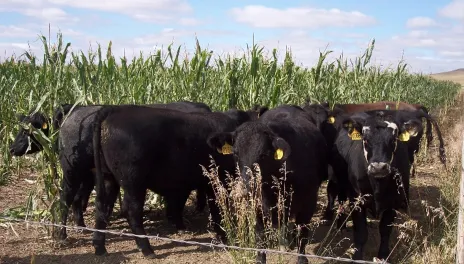DREC Integrated Crop and Livestock Research Shows Benefits
For the past 15 years, a multidisciplinary team of NDSU scientists and specialists have studied the impacts of integrating cattle and crop production and have seen significant results.
“Producers in our area were looking for regenerative agriculture practices to help restore their soil’s health and reduce the cost of production,” says Doug Landblom, animal scientist at NDSU’s Dickinson Research Extension Center and research team leader. “Our focus on crop production, beef production and soil health in an integrated system, seeks to understand how these things can work together to be profitable.”
As part of the study, yearling steers grazed on a crop rotation of spring wheat, cover crop, corn, field pea-barley mix and sunflower. Three of the rotation crops were harvested by grazing, instead of the traditional method, before the steers entered the feedlot.
The team found that:
- Keeping the steers grazing well beyond the normal grazing season, thus delaying their entry into the feedlot, saved feedlot costs, reduced sickness and antibiotic use, and produced yearlings that weighed considerably more than if they had gone through the traditional growing/finishing process.
- Employing a diverse multi-crop rotation with beef cattle grazing increased water infiltration and soil water holding capacity as well as improved and reduced reliance on commercial fertilizer application.
- Soil nutrients, especially nitrogen, increased, eliminating the need to apply nitrogen to the crops.
- Grazing reduced carbon dioxide and tended to reduce nitrous oxide greenhouse gases.
- Spring wheat yield and net return increased.
“The longer you allow cattle to graze, the more opportunities there are to make money,” says Landblom. “This approach requires a true paradigm shift, but I’m confident in saying that it shows multiple benefits for the cattle and the land.”
Others involved in the research, funded by Sustainable Agriculture Research and Education grants, include Songul Senturklu, a visiting scholar from Turkey; Larry Cihacek, Soil Science professor; Dr. Gerald Stokka, NDSU Extension veterinarian and livestock stewardship specialist; Rob Maddock, former Animal Sciences associate professor; Tim Petry, Extension livestock economist; Cheryl Wachenheim, Agribusiness and Applied Economics professor; and Steve Paisley, director, Sustainable Agricultural Research and Extension Center, University of Wyoming.
FOR MORE INFORMATION:
Forage Grazing Systems and Soil Health YouTube Video
Doug Landblom, 701-456-1109, douglas.landblom@ndsu.edu

